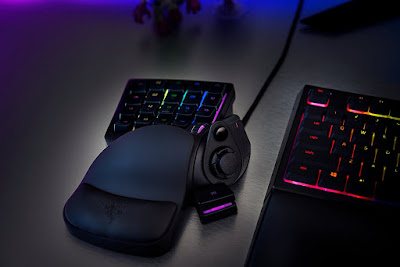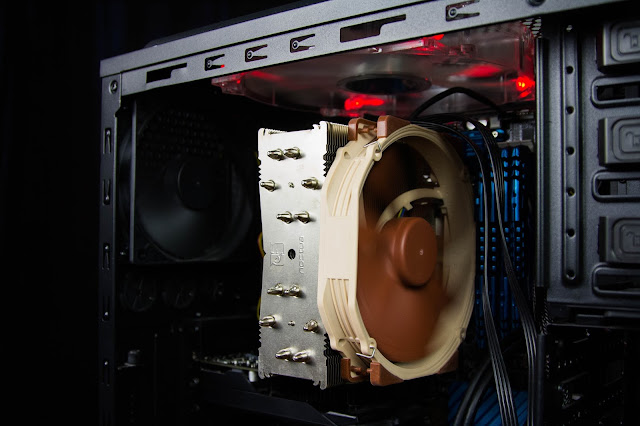Razer has a reputation for producing some of the coolest looking gaming-related hardware on the market, and the Razer Tartarus is no exception. Selling for about $80 a piece they are not too expensive either and is sure to appeal to a niche audience. Still, you might be wondering though -- is it worth getting? Does it offer a better experience than say, your old trusty mechanical gaming keyboard or is it just for show? Let us find out.
The Razer Tartarus V2 is a 25-key gaming keypad with a directional stick and a complete RGB lighting system. It's not as flexible as a full keyboard, but it can be a benefit to the hardest of hardcore gamers who don't need 104 keys to excel in their competitive games of choice.
What can you expect using one?
For a gaming keypad, the Tartarus works well and seem like your video gaming experience would be enhanced by a small, programmable keyboard with a directional stick. It is not the only gaming keypad made by Razer -- there is the elaborate "Orbweaver" which is more expensive but offers a more comfortable experience. In any case, these keypads can be used on a variety of gaming genres including competitive ones.
In this post, we will take a look at the Tartarus V2 in some categories. Only then can you decide if it is worth getting one
Design
Razer calls the Tartarus V2 an ergonomic gaming keypad -- it's a small keyboard that has four rows of 5 keys apiece (other than for the bottom row, where there's a scroll wheel in the location of the 5th secret) above a hand rest. Off to the side, there's an eight-directional D-pad, a small, circular button (Alt, by default) and a thumb button that usually operates as an area bar.
All told, 25 programmable buttons cover just about every key that you would regularly use on a full-sized keyboard. If you need only a handful of keys for whatever video game you're playing-- or whatever graphics style job you're working on-- it's easy to see the appeal.
User experience
However, the Tartarus V2 isn't nearly as comfortable as it could be. You can adjust the hand rest to one of 2 positions; however, in either case, you're going to be grabbing the top row of keys and the space bar, unless you have genuinely enormous hands.
The button that maps to S has a little ridge to assist you in identifying the movement keys by touch. However, the bump is extremely subtle, and I discovered that I typically reset my fingers one position to the left or right. That's bothersome in a single-player game, unsafe in a multiplayer match and positively fatal in a high-stakes competition match.
The Tartarus V2 isn't almost as comfortable as it might be.
Otherwise, the style is neat and compact. The Tartarus V2 saves a lot of room, which might be advantageous in a full tournament scene. In your home, however, you'll most likely have to use it in conjunction with a regular keyboard-- not instead of one. More on that later on.
Quality of the keys
Unfortunately, the Tartarus has one glaring fault that you won't be able to tell just by looking at it. Instead of mechanical switches, as Razer uses in most of its high-end keyboards, the Tartarus V2 goes with Razer's "Mecha-Membrane" -- the same one on their Ornata Chroma keyboard. In a nutshell, the keycaps simulate the feel of a mechanical keyboard, while still counting on a squishy membrane underneath.
Possibly Razer's target audience for the Tartarus V2 currently has all of those things, but it drives home the concept that the Tartarus V2 is a very, very niche product, even within the already-niche world of gaming devices.
At any rate, handled their own merits, the mecha-membrane works well for what it is. While they're not as satisfying as a mechanical switch, they're not as mushy as a membrane model, either. If you are used to using mechanical switches, this might be a deal breaker, but if you do not mind, either way, you will find that the keys are responsive and comfortable.
The D-pad was the more interesting component to assess. In the beginning, I believed it was a complete thumbstick, like on a video game controller; instead, it acts more like a set of arrow keys, with a command in between every two cardinal directions. Depending on the user's preference, it can be very useful or utterly useless.
What are the features?
Personally, we think it is surprising that products like the Tartarus V2 even exists. There aren't that many small-form video gaming keypads on the market, much less from major peripheral manufacturers. Regarding performance, though, whatever intriguing stems from the Razer Synapse 3.0 software application.
The Tartarus V2 lets you change in between 3 various keymaps, which is perfect for multiple characters in an MMO or MOBA, for different weapons layouts in an FPS or numerous races in an RTS.
As for customising the device using Synapse, well we found the experience finicky at best. The entire program feels sparse, with a lot of white backgrounds and area in between alternatives. Setting up Chroma lighting choices needs a little trial and error, although it instantly synchronises with other Razer items, which is a nice touch.
A critical function of the Tartarus V2 is that you can change between 3 different keymaps, which is perfect for different characters in an MMO or MOBA, for different weapons designs in an FPS or various races in an RTS. You can also make it possible for a "Hypershift" functionality, which entirely alters what every key does when you push or hold down a particular button.
While setting up these choices needs a great deal of time (and a great deal of effort, because you'll have to test and enhance your options in-game), you might, in theory, have nearly 150 various commands at your fingertips in each game. The only difficulty is that, by default, there are no secrets assigned to allowing Hypershift or swapping keymaps. Setting them isn't hard. However, it appears odd to make among the Tartarus V2's most beautiful elements an opt-in option instead of an endemic feature.
The very first thing you must understand is that if you want to use the Tartarus V2 successfully, you'll have to break years' worth of keyboard habits. When I played StarCraft: Remastered, I did my best to rely on the Tartarus V2. I configured all of my most often used commands into the 25 secrets, then attempted to train my fingers to acknowledge the unknown locations.
The issue wasn't a lot that the Tartarus V2 didn't work correctly-- it did-- it's just that I didn't see any clear benefit to training myself to utilise an entirely brand-new peripheral when a keyboard is both more spacious and more familiar. (Utilizing the D-pad to check out the minimap, on the other hand, was extremely useful, and let me micromanage my units a bit more effectively. This benefit isn't worth $80 by itself. However, it has a tangible result on gameplay.).
If you want to utilise the Tartarus V2 effectively, you'll have to break years' worth of keyboard habits.".
Overwatch was most likely where I saw the least enhancement. Yes, I might assign unique abilities to the keypad, but the D-pad didn't have a clear purpose, and the game doesn't benefit from macros. I make sure there are a handful of FPS snipers who might like having the additional scroll wheel, however, unless you're exceptionally uneasy with the mouse-and-keyboard setup, I don't see the Tartarus V2 having much of an effect.
World of Warcraft is probably where the Tartarus V2 showed the most utility. Top-level MMO play requires a lot of buttons, and can completely leverage macros to handle complicated DPS series or reliable healing chains. Especially considering that you can reprogram the keymap for different functions, MMO diehards might, in theory, take advantage of the Tartarus V2-- and an $80 device is perhaps a more appealing prospect than a large, dedicated MMO keyboard, with a price that could vary as much as $180.
On the other hand, a standard mouse-and-keyboard setup is still functional for the majority of MMO gamers-- which drives home my main criticism of the Tartarus V2. What it does, it does just fine; it's just not that useful-- or that necessary-- for many players.
The bottom line
There's a market for the Tartarus V2; after all, fans welcomed the first version enough to require a 2nd one. Still, having experimented with it in a few of my favourite video games (admittedly, at a low competitive level), it seems a bit like an option in search of a problem. The learning curve is high, the cost is high, and the benefits are moderate, at best.
The Tartarus V2 delivers what it says it can and if you can configure the device to meet your requirements. It will not, however, instantly make your gaming experience better as others might believe. You will have to spend some time getting used to the device and break away from your keyboard habits which are not easy to do. Many bought these gaming keypads only to have it sitting there like an expensive decorative piece. As for how long it will take and whether you can use the Tartarus to improve your game, well that is subjective. Personally though -- I would rather spend my $80 elsewhere.




























